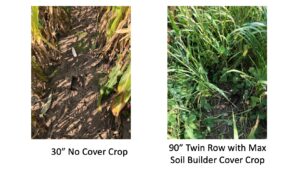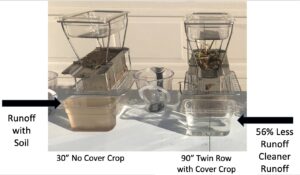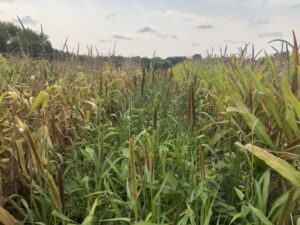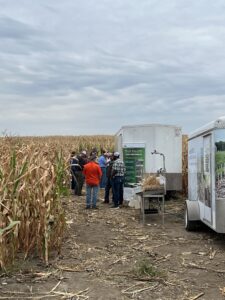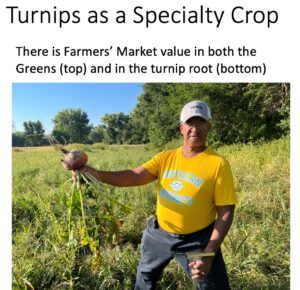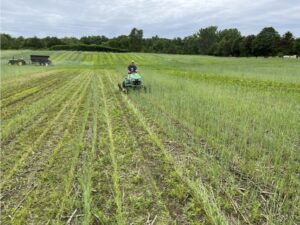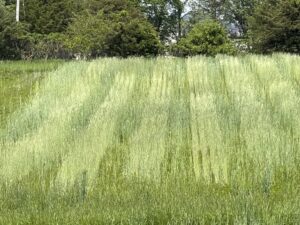Final report for FNC22-1348
Project Information
I have been aggressively pursuing improved farming practices on land owned by my various collaborators and others since my retirement from a Corporate job in 2008. My process has evolved thru No-Till farming, Strip Intercropping with a Corn/Bean system, to wide row corn for better sunlight utilization, which has led to a focus on cover crops to improve Water Quality by reduced runoff, and better soil health. My current efforts go back and forth between better, more effective cover crops, and higher corn yield to enable and encourage cover crop adoption. I am making progress; a number of others are following my lead, especially those with livestock to graze. I have no livestock in my operation. I am directly involved in approximately 110 acres and indirectly involved in management decisions for several thousand acres.
Cover Crops are known to improve soil and water quality, but adoption has been slower than desired. My 2021/2022 SARE Project,
(FNC21-1297 - Demonstration of Utilization of Cover Crops in Wide Row Corn to Improve Soil Health Demonstration of the soil and water benefits of using widely spaced corn rows (60" or 90") to provide full season sunlight to cover, companion, and beneficial crops while maintaining near equivalent total field corn yields. Comparison strips will be used. Results will be shared in field days) referred to above, provided an opportunity for side-by-side comparison of 30” corn with no cover crop vs. 90” Twin Row corn with an aggressive multi-species cover crop mix. Samples from those plots demonstrated a 56% reduction in water runoff, based on four replications. Equally important, the runoff water was cleaner. This project enables demonstration on more grower-owned plots with side-by-side replicated trials of various cover crop treatments. Reference imagery from 2021 below:
A key element of this work is for the plots to demonstrate alternative treatments on the grower's own property. For the results to be credible to the grower, the alternative practice should be compared directly to traditional practices. This is important to demonstrate any changes in cash crop yields, weed pressure, runoff water, and nutrient requirements. The risk to the grower's operations can be minimized by using small equipment to create small plots. This grant enables efficient and quick seeding of small plots with small equipment in grower fields, and provides measurement/demonstration equipment for end of season environmental impact information in additional to traditional yield measurements.
- Compare cover crop vigor in wide (60'' or 90") row corn plots on grower property vs. cover crop planted in traditional (20'' or 30") rows.
- Document early season cover crop growth vs cash crop.
- Document differences in early, mid, and late season weed suppression in the various treatments.
- Measure water runoff differences in wide row cover crop spaces vs traditional row spaces.
- Measure yield differences in the various replicated trial treatments.
- Record with imagery and measure differences in cover crop biomass in the various treatments.
Cooperators
Research
I use my equipment to plant corn in much wider than normal rows. Traditional spacing in this area is 30 inches; my work over the past several years was on 60 inch rows, and I am now moving to 90 in rows. There is a corn yield reduction, but a much greater, more healthy and lush cover crop possible due to the added sunlight. I drill in the cover crop right after planting, and often supplement it later in the season, followed by another application in the fall if needed. I try to not kill the cover, but rather co-exist with the corn crop. This is a bit risky but very beneficial to the cover crop and soil health. We are continuing to fine tune and share the process and the learning, including from dramatic failures!
Please refer to the linked Power Point presentation for a full description.
This report was made to the Black Hawk County Soil and Water Conservation District meeting on 13 Dec 2022, and covers the work under this grant project well.
Educational & Outreach Activities
Participation Summary:
I am active on facebook and YouTube with reports and updates of my work.
The link below is to the YouTube playlist of 11 video files which were recorded at the field day on 30 September 2022. They are at:
I also have scheduled a Zoom meeting on 16 December 2022 which will be notified on Twitter, Facebook and by my e-mail list. My facebook postings are normally viewed by 120+ persons.
I had a well attended field day on 15 September 2023 with excellent participation by both industry (Corteva/Pioneer) experts, USDA representatives, and successful local farmers. Approximately 25 people were in attendance. A photo is attached.
Learning Outcomes
This has been an adventure in learning and humility. We have experienced great joy in seeing lush cover crops between our corn rows, the soil looks and feels better, and this just seems like the right way to do things. However, we have struggled to get an acceptable corn crop consistently. In 2022, on Mike Cook's field, we had some excellent rows with corn yielding over 200 bu/a. But nearby in the much drier, lighter soil, we struggled to get any yield. In 2023, with a much drier season, we did not get a harvestable crop. But in the Opportunity Space between the corn rows, we had an excellent crop of turnips that were highly valued in the local farmers' market. These were drilled in the cover crop, and survived and thrived well along with the cover crops. The revenue from the turnips exceeded what Mike would have gained from the corn alone.
Our goal, going forward is to develop management techniques to harvest BOTH a good corn crop and more high value vegetables in the same space, in a good year.
More detail about Mike's soil conditions and our struggles are contained in the PowerPoint file below:
In Graham Thompson's field, we have continued our aggressive movement to a fully organic operation. This has placed severe limits on our ability to address the weed population in his light soil, especially in these dry years. We do not have this all figured out yet. Graham has grazed sheep on the field, and has a moveable chicken pen to gain revenue from the field. This has been productive. We are continuing to explore alternate cover crops, and what we can learn from his soil samples to improve the conditions. Lime was added this year to improve the pH of the soil, which is currently very acidic. The dry season in 2023 has added to the challenge, but we continue to press forward in our learning and experiences.
There is more detail in the PowerPoint below:
Project Outcomes
As an outreach resulting from visibility in the agriculture industry of my various previous experiments, we were given access to a field of "very good" soil operated by a very large farm operation a few miles from here. We conducted wide row vs traditional replicated trials in that field this season, with very good results. The local USDA rep called me in the fall and said "You are making a difference, that grower (name withheld) is now starting to use cover crops on his fields. That is a first for them; it should be a good model for others to watch him carefully.
The Farmer's Market experience we had this year was a delight. In spite of a failed corn crop in very marginal soil conditions due the the dry season, we had a very nice turnip crop that was very marketable. The revenue from the turnips sales exceeded what we would have received from a traditional corn crop. In the future, we hope to have BOTH the corn and vegetable crops generating revenue on the same field due to the Opportunity Space concept.
This process has been very effective for me in enabling collaboration with several growers who have very different business models, and very limited time and energy for experiments of the type I like to do to explore relatively "radical" concepts, such as the Opportunity Space between wide row corn.
It simply would not be possible for me to continue this work without the support of SARE.
My suggestion is that SARE bring a relative open mind to these experiments; the industry is very good at incremental changes; USDA/SARE has a very key role to play in enabling independent research and explorations of non-traditional solutions to well known problems.
